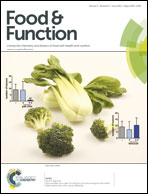Interactions among chemical components of Cocoa tea (Camellia ptilophylla Chang), a naturally low caffeine-containing tea species
Abstract
In the 1980s, a novel tea species, Cocoa tea (Camellia ptilophylla Chang), was discovered in Southern China with surprisingly low caffeine content (0.2% by dry weight). Although its health promoting characteristics have been known for a while, a very limited amount of scientific research has been focused on Cocoa tea. Herein, a systematic study on Cocoa tea and its chemical components, interactions and bioactivities was performed. YD tea (Yunnan Daye tea, Camellia sinensis), a tea species with a high caffeine content (5.8% by dry weight), was used as a control. By UV-Vis spectrometry, High Performance Liquid Chromatography (HPLC), and Flame Atomic Absorption Spectrometry (FAAS) for chemical composition analysis, C-2 epimeric isomers of tea catechins and theobromine were found to be the major catechins and methylxanthine in Cocoa tea, respectively. More gallated catechins, methylxanthines, and proteins were detected in Cocoa tea compared with YD tea. Moreover, the tendency of major components in Cocoa tea for precipitation was significantly higher than that in YD tea. Catechins, methylxanthines, proteins, iron, calcium, and copper were presumed to be the origins of molecular interactions in Cocoa tea and YD tea. The interactions between catechins and methylxanthines were highly related to the galloyl moiety in catechins and methyl groups in methylxanthines. In vitro anti-inflammatory activity assays revealed that Cocoa tea was a more potent inhibitor of nitric oxide (NO) in lipopolysaccharide (LPS)-stimulated macrophage cells (RAW 264.7) than YD tea. This study constructs a solid phytochemical foundation for further research on the mechanisms of molecular interactions and the integrated functions of Cocoa tea.


 Please wait while we load your content...
Please wait while we load your content...